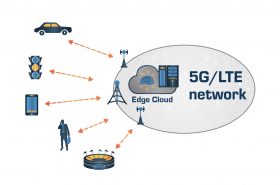Infiot Taps the Smart Edge with Microsoft Azure

Infiot, an edge networking and compute company targeting Internet of Things (IoT) and other "edge" applications in industry verticals, today announced an integration with Microsoft Azure that will help deliver last-mile workflow streaming with Infiot's edge devices and cloud service.
Infiot will integrate its lightweight edge devices and cloud software with Microsoft Azure, including introducing one-click operations and automated connectivity to Azure IoT using integration via application programming interfaces (APIs).
The joint solution can help tap IoT sensor data, deploy applications, and accelerate the transmission and collection of data headed to Azure IoT Hub. It's designed to enable capabilities like analytics and machine learning.
Infiot Goes Remote First
Infiot, founded by a team that includes many people from the pioneering VeloCloud team (acquired by VMware), is taking principles of software-defined wide-area networking (SD-WAN) and extending those into new markets where lighter-weight devices, seamless security, and low power consumption are key.
SD-WAN has been a successful market -- the SD-WAN technology platform market has a compound annual growth rate (CAGR) of 34%, in Futuriom's estimation -- but it has so far been limited to data centers and enterprise branches. By introducing a lightweight, low-power edge device that can provide compute capabilities and support low-power Arm platforms, Infiot thinks it can expand the market for cloud networking into places like medical devices, financial services, and industrial markets. It already has customers in several of these areas, including Christus Health and ATSU.
Highlights of Azure Partnership
Infiot Intelligent Access includes converged connectivity, zero trust security, and edge compute while connecting IoT devices over LTE and 5G cellular networks. These thin devices collect data from various assets and sensors running on many protocols. The Infiot platform can also be used to govern data ownership.
Here are the highlights of the Microsoft partnership, according to Infiot:
- Azure IoT Edge Runtime deployed on Infiot Edges: Complete lifecycle of container management for Azure IoT Edge Runtime and service modules with policy-based workflows.
- Automated Azure IoT Hub Connection: With API integration, Azure IoT Edges automatically connect to the Azure IoT Hubs and IoT devices are auto-provisioned in the IoT Hub via a Device Provisioning Service.
- Zero Trust Security: Comprehensive security functionality safeguards IoT traffic from sensor devices to Azure IoT Cloud.
- Infiot Private Access: Access IoT devices securely from anywhere with remote maintenance and troubleshooting with Infiot Private Access.
- Ruggedized Form Factor: Connect Azure IoT Edge Runtime deployed on ruggedized Infiot Edges to Azure IoT cloud over wired or wireless (LTE/5G) WAN with complete link visibility and insights.
- Infiot Store and Forward: Upon blackout conditions, Infiot Extensible Edge locally stores telemetry data bound for Azure IoT Hub. Once connectivity is restored, locally stored messages are delivered to IoT Hub.
On the Edge of Digital Transformation
As Futuriom will detail in an upcoming Leadership Brief, Infiot is well-positioned to solve some of the leading problems of the remote edge, a need that is being accelerated by digital transformation efforts catalyzed by the COVID pandemic.
The arrival of COVID proved that many organizations were ill-equipped to quickly transition to a remote-first, digital environment. This approach will be more common and remote-access arrangements will become part of the “new normal.” At the same time, many organizations worldwide have realized they were not well prepared for the crisis. They are now accelerating their digital transformation plans in response. This requires new capabilities to connect and enable remote devices and technologies. For example, accelerated digital transformation will include wider use of collaboration, business analytics, cybersecurity, and remote sensing technologies for digitized industry, such as virtual reality and augmented reality (VR/AR).
Infiot is targeting some of the needs here by providing many capabilities at the edge – the place where people and things connect to the cloud, the Internet, or an enterprise network. This new partnership with Microsoft is a savvy move that will leverage Azure's strength in IoT and enterprise edge connectivity.


















